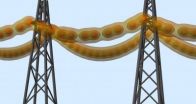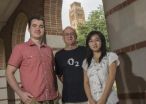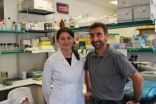(Press-News.org) Applying just the right amount of tension to a chain of carbon atoms can turn it from a metallic conductor to an insulator, according to Rice University scientists.
Stretching the material known as carbyne -- a hard-to-make, one-dimensional chain of carbon atoms -- by just 3 percent can begin to change its properties in ways that engineers might find useful for mechanically activated nanoscale electronics and optics.
The finding by Rice theoretical physicist Boris Yakobson and his colleagues appears in the American Chemical Society journal Nano Letters.
Until recently, carbyne has existed mostly in theory, though experimentalists have made some headway in creating small samples of the finicky material. The carbon chain would theoretically be the strongest material ever, if only someone could make it reliably.
The first-principle calculations by Yakobson and his co-authors, Rice postdoctoral researcher Vasilii Artyukhov and graduate student Mingjie Liu, show that stretching carbon chains activates the transition from conductor to insulator by widening the material's band gap. Band gaps, which free electrons must overcome to complete a circuit, give materials the semiconducting properties that make modern electronics possible.
In their previous work on carbyne, the researchers believed they saw hints of the transition, but they had to dig deeper to find that stretching would effectively turn the material into a switch.
Each carbon atom has four electrons available to form covalent bonds. In their relaxed state, the atoms in a carbyne chain would be more or less evenly spaced, with two bonds between them. But the atoms are never static, due to natural quantum uncertainty, which Yakobson said keeps them from slipping into a less-stable Peierls distortion.
"Peierls said one-dimensional metals are unstable and must become semiconductors or insulators," Yakobson said. "But it's not that simple, because there are two driving factors."
One, the Peierls distortion, "wants to open the gap that makes it a semiconductor." The other, called zero-point vibration (ZPV), "wants to maintain uniformity and the metal state."
Yakobson explained that ZPV is a manifestation of quantum uncertainty, which says atoms are always in motion. "It's more a blur than a vibration," he said. "We can say carbyne represents the uncertainty principle in action, because when it's relaxed, the bonds are constantly confused between 2-2 and 1-3, to the point where they average out and the chain remains metallic."
But stretching the chain shifts the balance toward alternating long and short (1-3) bonds. That progressively opens a band gap beginning at about 3 percent tension, according to the computations. The Rice team created a phase diagram to illustrate the relationship of the band gap to strain and temperature.
How carbyne is attached to electrodes also matters, Artyukhov said. "Different bond connectivity patterns can affect the metallic/dielectric state balance and shift the transition point, potentially to where it may not be accessible anymore," he said. "So one has to be extremely careful about making the contacts."
"Carbyne's structure is a conundrum," he said. "Until this paper, everybody was convinced it was single-triple, with a long bond then a short bond, caused by Peierls instability." He said the realization that quantum vibrations may quench Peierls, together with the team's earlier finding that tension can increase the band gap and make carbyne more insulating, prompted the new study.
"Other researchers considered the role of ZPV in Peierls-active systems, even carbyne itself, before we did," Artyukhov said. "However, in all previous studies only two possible answers were being considered: either 'carbyne is semiconducting' or 'carbyne is metallic,' and the conclusion, whichever one, was viewed as sort of a timeless mathematical truth, a static 'ultimate verdict.' What we realized here is that you can use tension to dynamically go from one regime to the other, which makes it useful on a completely different level."
Yakobson noted the findings should encourage more research into the formation of stable carbyne chains and may apply equally to other one-dimensional chains subject to Peierls distortions, including conducting polymers and charge/spin density-wave materials.
INFORMATION:
Read the abstract at http://pubs.acs.org/doi/abs/10.1021/nl5017317
Follow Rice News and Media Relations via Twitter @RiceUNews
Yakobson Research Group: http://biygroup.blogs.rice.edu
Rice University Department of Materials Science and NanoEngineering: http://msne.rice.edu
Located on a 300-acre forested campus in Houston, Rice University is consistently ranked among the nation's top 20 universities by U.S. News & World Report. Rice has highly respected schools of Architecture, Business, Continuing Studies, Engineering, Humanities, Music, Natural Sciences and Social Sciences and is home to the Baker Institute for Public Policy. With 3,920 undergraduates and 2,567 graduate students, Rice's undergraduate student-to-faculty ratio is just over 6-to-1. Its residential college system builds close-knit communities and lifelong friendships, just one reason why Rice has been ranked No. 1 for best quality of life multiple times by the Princeton Review and No. 2 for "best value" among private universities by Kiplinger's Personal Finance.
Carbyne morphs when stretched
Rice University calculations show carbon-atom chain would go metal to semiconductor
2014-07-21
ELSE PRESS RELEASES FROM THIS DATE:
Philosopher uses game theory to understand how words, actions acquire meaning
2014-07-21
MANHATTAN, KANSAS -- Why does the word "dog" have meaning? If you say "dog" to a friend, why does your friend understand you?
Kansas State University philosopher Elliott Wagner aims to address these types of questions in his latest research, which focuses on long-standing philosophical questions about semantic meaning. Wagner, assistant professor of philosophy, and two other philosophers and a mathematician are collaborating to use game theory to analyze communication and how it acquires meaning.
"If I order a cappuccino at a coffee shop, I usually don't think about ...
New technique uses 'simulated' human heart to screen drugs
2014-07-21
A Coventry University scientist has developed a pioneering new way – using samples of beating heart tissue – to test the effect of drugs on the heart without using human or animal trials.
The breakthrough is the work of Dr Helen Maddock – an expert in cardiovascular physiology and pharmacology from the University's Centre for Applied Biological and Exercise Sciences – and could lead to the lives of hundreds of future patients being saved and the quality of their treatments improved.
Adverse effects of drugs on the cardiovascular system are a major cause of many medical ...
Age-related macular degeneration occurs much earlier than previously assumed
2014-07-21
It is widely accepted that age-related macular degeneration (AMD) is the most common cause of visual impairment and blindness in industrialized countries. However, it is questionable whether it can continue to be defined as a disease in people in their 50s and beyond. Investigations to determine the incidence of age-related macular degeneration undertaken as part of the Gutenberg Health Study of the University Medical Center of Johannes Gutenberg University Mainz (JGU) have shown that even persons under the age of 50 years may be affected by an early form of the eye disease. ...
Our daily bread
2014-07-21
Bread wheat (Triticum aestivum L.) is the most widely cultivated cereal crop in the world and provides 20 percent of the food calories consumed by humans. A polyploid species, hexaploid bread wheat contains six duplicated copies of its genome and is more than five times larger than the human genome. This makes genome research in wheat particularly difficult.
Dr. Klaus Mayer, Head of the Research Unit Plant Genome and Systems Biology at HMGU, in collaboration with his colleagues Matthias Pfeifer, Dr. Karl Kugler and Manuel Spannagl, succeeded in gaining insights into complex ...
Described novel regulator of a protein inactive in over 50 percent of human tumors
2014-07-21
Researchers at the Bellvitge Biomedical Research Institute (IDIBELL) and the University of Barcelona have discovered the interaction between HERC2 proteins with another protein called p53 that is inactivated in more than half of human tumors. The study results were published in the Journal of Biological Chemistry.
Regulation of the activity of p53 by HERC2
The team of José Luis Rosa, at the growth factors and cell differentiation research group at IDIBELL studies the molecular mechanisms of HERC family proteins. These proteins are ubiquitin ligases that regulate the ...
Potential new flu drugs target immune response, not virus
2014-07-21
The seriousness of disease often results from the strength of immune response, rather than with the virus, itself. Turning down that response, rather than attacking the virus, might be a better way to reduce that severity, says Juliet Morrison of the University of Washington, Seattle. She and her collaborators have now taken the first step in doing just that for the H7N9 influenza, and their work has already led to identification of six potential therapeutics for this highly virulent strain. The research is published ahead of print in the Journal of Virology.
"We set ...
More than glitter
2014-07-21
A special class of tiny gold particles can easily slip through cell membranes, making them good candidates to deliver drugs directly to target cells.
A new study from MIT materials scientists reveals that these nanoparticles enter cells by taking advantage of a route normally used in vesicle-vesicle fusion, a crucial process that allows signal transmission between neurons. In the July 21 issue of Nature Communications, the researchers describe in detail the mechanism by which these nanoparticles are able to fuse with a membrane.
The findings suggest possible strategies ...
Mammals metabolize some pesticides to limit their biomagnification
2014-07-21
The concentrations of many historically used, and now widely banned, pesticides and other toxic chemicals—called legacy contaminants—can become magnified in an animal that eats contaminated food; however, a new Environmental Toxicology & Chemistry study has found that Arctic mammals metabolize some currently used pesticides, preventing such 'biomagnification.'
Researchers who studied the vegetation-caribou-wolf food chain in the Bathurst region of Canada say that currently use pesticides enter the food chain and become concentrated in vegetation, but the evidence shows ...
Examining the causes of a devastating debris flow
2014-07-21
Storm-triggered landslides cause loss of life, property damage, and landscape alterations. For instance, the remnants of Hurricane Camille in 1969 caused 109 deaths in central Virginia, after 600 mm of rain fell in mountainous terrain in 6 hours. More recently, on 8 August 2010, a rainstorm-induced landslide devastated the Chinese county of Zhouqu, causing more than 1000 deaths. A new modeling study by Ren (Geophysical Research Letters) examines the multiple factors, both natural and human caused, that came together to produce this event. The triad of storm-triggered landslides ...
New research links bad diet to loss of smell
2014-07-21
TALLAHASSEE, Fla. — Could stuffing yourself full of high-fat foods cause you to lose your sense of smell?
A new study from Florida State University neuroscientists says so, and it has researchers taking a closer look at how our diets could impact a whole range of human functions that were not traditionally considered when examining the impact of obesity.
"This opens up a lot of possibilities for obesity research," said Florida State University post-doctoral researcher Nicolas Thiebaud, who led the study examining how high-fat foods impacted smell.
Thiebaud led the ...
LAST 30 PRESS RELEASES:
School meals could unlock major gains for human and planetary health
Menopause hormone therapy does not appear to impact dementia risk
Signature patterns of brain activity may help predict recovery from traumatic brain injury
Dresden study uncovers new key mechanism in cancer cells
New species are now being discovered faster than ever before, study suggests
Cannabis-based products show limited short-term benefit for chronic pain, with increased risk of adverse effects
Cannabis products with more THC slightly reduce pain but cause more side effects
Clearing the brain of aging cells could aid epilepsy and reduce seizures
Brain injuries linked with potential risk of suicide, new study finds
New technique lights up where drugs go in the body, cell by cell
New study finds movement of fishing fleets can reveal shifts in marine ecosystems
Embargoed: New evidence points to potential treatment for vascular dementia
Study uncovers disrupted brain balance in alcohol dependence
Working in groups can help Republicans and Democrats agree on controversial content moderation online
Structural findings reveal how distinct GPCR ligands create different levels of activation
Anything-goes “anyons” may be at the root of surprising quantum experiments
UC review: Maximizing workplace opportunity for veterans
From generation to complex control: Metasurfaces make perfect vortex beams "within reach"
Thin-film lithium niobate-based detector: recent advances and perspectives
Exploring why some people may tend to persistently make bad choices
How cells balance their protein levels
Nirsevimab vs RSVpreF vaccine for RSV–related hospitalization in newborns
Effectiveness and impact of maternal RSV immunization and nirsevimab on medically attended RSV in US children
AI gives scientists a boost, but at the cost of too many mediocre papers
Next-generation vision model maps tree growth at sub-meter precision
Genes aren’t destiny for inherited blindness, study shows
MIT study: High-fat diets make liver cells more likely to become cancerous
Exposure to multiple fine particulate matter components and incident depression in the US Medicare population
Risk of burdensome health care spending over time in the US
Nirsevimab against hospitalizations and emergency department visits for lower respiratory tract infection in infants
[Press-News.org] Carbyne morphs when stretchedRice University calculations show carbon-atom chain would go metal to semiconductor






